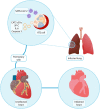Type 2 alveolar epithelial cell-derived circulating extracellular vesicle-encapsulated surfactant protein C as a mediator of cardiac inflammation in COVID-19
- PMID: 35909187
- PMCID: PMC9340698
- DOI: 10.1007/s00011-022-01612-z
Type 2 alveolar epithelial cell-derived circulating extracellular vesicle-encapsulated surfactant protein C as a mediator of cardiac inflammation in COVID-19
Abstract
Among the countless endeavours made at elucidating the pathogenesis of COVID-19, those aimed at the histopathological alterations of type 2 alveolar epithelial cells (AT2) are of outstanding relevance to the field of lung physiology, as they are the building blocks of the pulmonary alveoli. A merit of high regenerative and proliferative capacity, exocytotic activity resulting in the release of extracellular vesicles (EVs) is particularly high in AT2 cells, especially in those infected with SARS-CoV-2. These AT2 cell-derived EVs, containing the genetic material of the virus, might enter the bloodstream and make their way into the cardiovascular system, where they may infect cardiomyocytes and bring about a series of events leading to heart failure. As surfactant protein C, a marker of AT2 cell activity and a constituent of the lung surfactant complex, occurs abundantly inside the AT2-derived EVs released during the inflammatory stage of COVID-19, it could potentially be used as a biomarker for predicting impending heart failure in those patients with a history of cardiovascular disease.
Keywords: COVID-19; Cardiac inflammation; Extracellular vesicle; Surfactant protein C; Type 2 alveolar epithelial cell.
© 2022. The Author(s), under exclusive licence to Springer Nature Switzerland AG.
Conflict of interest statement
No conflicts of interest, financial or otherwise, are declared by the authors.
Figures

Similar articles
-
Recombinant ACE2 Expression Is Required for SARS-CoV-2 To Infect Primary Human Endothelial Cells and Induce Inflammatory and Procoagulative Responses.mBio. 2020 Dec 11;11(6):e03185-20. doi: 10.1128/mBio.03185-20. mBio. 2020. PMID: 33310781 Free PMC article.
-
Culture of human alveolar epithelial type II cells by sprouting.Respir Res. 2018 Oct 19;19(1):204. doi: 10.1186/s12931-018-0906-9. Respir Res. 2018. PMID: 30340591 Free PMC article.
-
Function of epithelial stem cell in the repair of alveolar injury.Stem Cell Res Ther. 2022 Apr 27;13(1):170. doi: 10.1186/s13287-022-02847-7. Stem Cell Res Ther. 2022. PMID: 35477551 Free PMC article. Review.
-
Extracellular Vesicle Associated miRNAs Regulate Signaling Pathways Involved in COVID-19 Pneumonia and the Progression to Severe Acute Respiratory Corona Virus-2 Syndrome.Front Immunol. 2021 Dec 9;12:784028. doi: 10.3389/fimmu.2021.784028. eCollection 2021. Front Immunol. 2021. PMID: 34956213 Free PMC article.
-
Beyond Borders of the Cell: How Extracellular Vesicles Shape COVID-19 for People with Cystic Fibrosis.Int J Mol Sci. 2024 Mar 27;25(7):3713. doi: 10.3390/ijms25073713. Int J Mol Sci. 2024. PMID: 38612524 Free PMC article. Review.
Cited by
-
Extracellular Vesicles and Their Role in Lung Infections.Int J Mol Sci. 2023 Nov 9;24(22):16139. doi: 10.3390/ijms242216139. Int J Mol Sci. 2023. PMID: 38003329 Free PMC article. Review.
-
Proteomics of blood extracellular vesicles in inflammatory respiratory diseases for biomarker discovery and new insights into pathophysiology.Inflamm Regen. 2024 Sep 18;44(1):38. doi: 10.1186/s41232-024-00351-4. Inflamm Regen. 2024. PMID: 39294831 Free PMC article. Review.
-
Transcriptomic responses of cumulus granulosa cells to SARS-CoV-2 infection during controlled ovarian stimulation.Apoptosis. 2024 Jun;29(5-6):649-662. doi: 10.1007/s10495-024-01942-9. Epub 2024 Feb 26. Apoptosis. 2024. PMID: 38409352
References
-
- Allaerts W. Biophysical parameters affecting lung surfactant function, surface tension and the transition from aerosol to droplet exhalation (in relation to COVID-19 infection. J Phys Conf Ser. 2021;1730:012059. doi: 10.1088/1742-6596/1730/1/012059. - DOI
Publication types
MeSH terms
Substances
LinkOut - more resources
Full Text Sources
Medical
Research Materials
Miscellaneous

